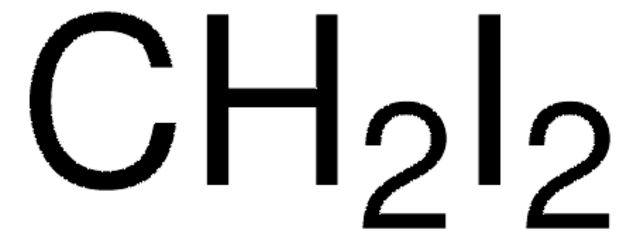Alle Fotos(1)
Wichtige Dokumente
206326
Dibromchlormethan
97%
Synonym(e):
Chlordibrommethan
Anmeldenzur Ansicht organisationsspezifischer und vertraglich vereinbarter Preise
Alle Fotos(1)
About This Item
Lineare Formel:
Br2CHCl
CAS-Nummer:
Molekulargewicht:
208.28
Beilstein:
1731046
EG-Nummer:
MDL-Nummer:
UNSPSC-Code:
12352100
PubChem Substanz-ID:
NACRES:
NA.22
Empfohlene Produkte
Qualitätsniveau
Assay
97%
Form
liquid
Brechungsindex
n20/D 1.547 (lit.)
bp
119-120 °C/748 mmHg (lit.)
mp (Schmelzpunkt)
−22 °C (lit.)
Löslichkeit
acetone: soluble
diethyl ether: soluble
ethanol: soluble
Dichte
2.451 g/mL at 25 °C (lit.)
Funktionelle Gruppe
bromo
chloro
Lagertemp.
2-8°C
SMILES String
ClC(Br)Br
InChI
1S/CHBr2Cl/c2-1(3)4/h1H
InChIKey
GATVIKZLVQHOMN-UHFFFAOYSA-N
Suchen Sie nach ähnlichen Produkten? Aufrufen Leitfaden zum Produktvergleich
Anwendung
Affords bromochlorocarbene under phase-transfer conditions.
Hier finden Sie alle aktuellen Versionen:
Besitzen Sie dieses Produkt bereits?
In der Dokumentenbibliothek finden Sie die Dokumentation zu den Produkten, die Sie kürzlich erworben haben.
Kunden haben sich ebenfalls angesehen
Synthesis, 857-857 (1991)
P Bocchini et al.
Rapid communications in mass spectrometry : RCM, 13(20), 2049-2053 (1999-10-08)
The analysis of organic pollutants in drinking water is a topic of wide interest, reflecting on public health and life quality. Many different methodologies have been developed and are currently employed in this context, but they often require a time-consuming
Qiang Zeng et al.
Environment international, 54, 134-140 (2013-03-05)
Toxicological studies showed that trihalomethanes (THMs), the most abundant classes of disinfection by-products (DBPs) in drinking water, impaired male reproductive health, but epidemiological evidence is limited and inconsistent. This study aimed to examine the associations of baseline blood THMs with
S Landi et al.
Mutagenesis, 14(5), 479-482 (1999-09-03)
The brominated trihalomethanes (THMs) are mutagenic and carcinogenic disinfection by-products frequently found in chlorinated drinking water. They can be activated to mutagens by the product of the glutathione S-transferase-Theta (GSTT1++-1) gene in Salmonella RSJ100, which has been transfected with this
M Luciene da Silva et al.
Toxicology letters, 106(1), 49-57 (1999-06-23)
Trihalomethanes (THMs; chloroform, bromoform, bromodichloromethane, dibromochloromethane), formed as by-products of chlorine disinfection, are found to occur in combination in drinking water supplies. THMs are metabolized by cytochromes P-450 and are likely substrates of CYP2E1. Therefore, it is possible that mixed
Unser Team von Wissenschaftlern verfügt über Erfahrung in allen Forschungsbereichen einschließlich Life Science, Materialwissenschaften, chemischer Synthese, Chromatographie, Analytik und vielen mehr..
Setzen Sie sich mit dem technischen Dienst in Verbindung.

